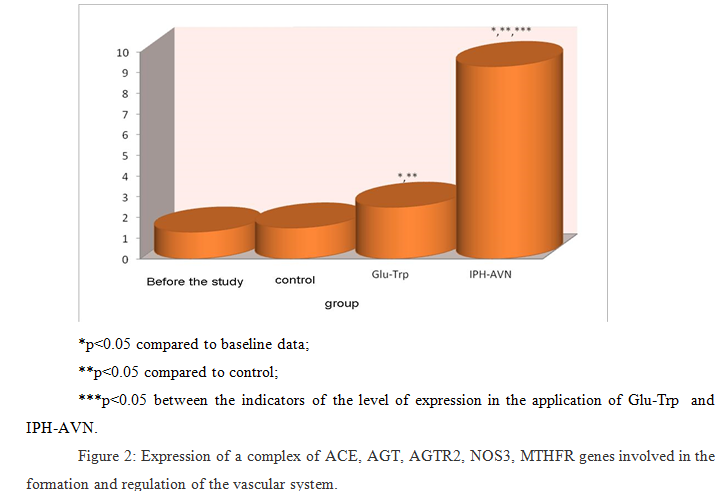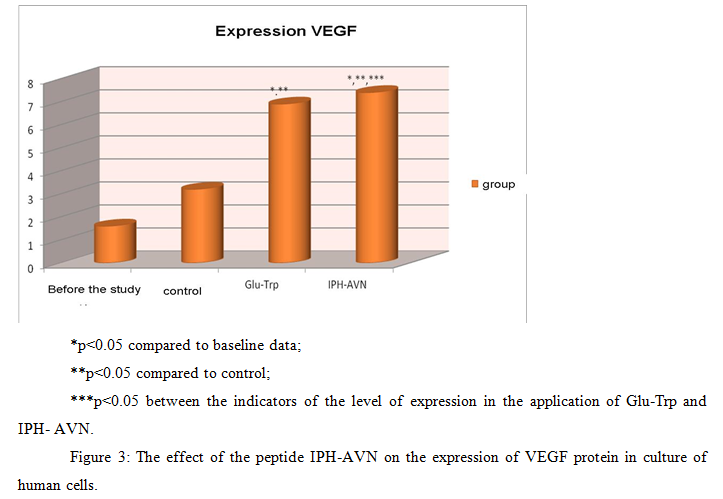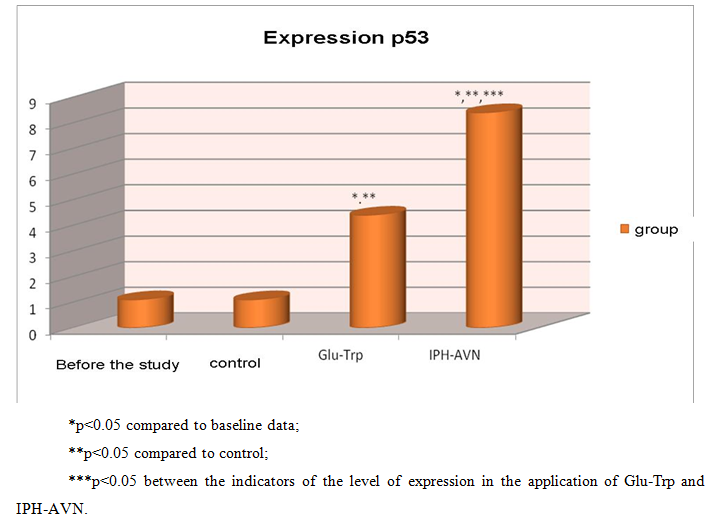At the present time the study of the peptides’ properties [Dudgeon W. D. et others, 2016] has a high interest. Peptides have the same structure as proteins, but the size of these molecules is smaller. It is also important to note that short peptides, being a natural metabolic product present in the body, cannot be identified in blood or urine. In this case the study of the properties of individual structures can only be provided on cell cultures.
Peptide IPH — AVN contains a low molecular weight peptide, has angioprotective and vasoprotective properties and has a normalizing effect on the vascular system.
Experimental studies have shown that the peptide IPH — AVN regulates metabolic processes in blood vessels, reduces the permeability of the vascular wall, increases the reserve capacity of the body, which allows to predict the effectiveness of the peptide IPH — AVN to normalize the functions of the human vascular system in violations of various origins.
Thus, the aim of the current study was to study angioprotective and other peptide’s properties.
Study design
1 stage.
To evaluate the cytostatic and agioprotective of the peptide IPH-AVN properties in relation to the vascular system, we have chosen embryonic stem cells (ESCs), which are pluripotent type, which means that they can be differentiated into all three primary germ sheets: ectoderm, endoderm and mesoderm, from which later formed the tissues of the vascular system. The human embryo reaches the blastocyst stage, from which stem cells are obtained on the 5 or 6 days after fertilization.
Genes responsible for the formation of the vascular system make up a complex of ACE, AGT, AGTR2, NOS3, MTHFR genes. ACE gene (angiotensin-1 converting enzyme — ACE) is mapped in 17q23 locus. AGT and AGTR1 GENES, which encode angiotensinogen and receptor type 1 to angiotensin II, and the product of the gene NOS3 — NO-synthase — is a key enzyme in the regulation of blood vessel tone, smooth muscle of the vascular wall and thrombosis. The methylene tetrahydrofolate reductase (MTHFR) gene regulates homocysteine metabolism in the cell. NOS3 and MTHFR genes polymorphisms are associated with predisposition to cardiovascular disease.
On these data, we decided to study the activity of this complex of genes in the application of the peptide IPH — AVN.
We evaluated the expression of genes responsible for the vascular system ontogenesis.
2 stage.
The second stage of the experimental study was the evaluation of marker biological active molecules by immunofluorescence method using primary antibodies to VEGF protein (1:250, Abcam) and p53 protein (1:50, Abcam).
We have selected the following marker biologically active molecules:
1) VEGF (vascular endothelial growth factor) — signal protein produced by cells to stimulate vasculogenesis (formation of embryonic vascular system) and angiogenesis (growth of new vessels in the existing vascular system) [Anteby E.Y. et al., 2004].
2) Aging of polypotent cells in culture is associated with increased activity of the p53 gene. In mice with mutation in the p53 gene, there was increased resistance to the development of tumors, combined with a reduction in life expectancy. P53 protein plays a key role in endogenous antitumor mechanisms [Donekover et al., 2002]. P53 protein controls the course of cell cycle processes, as well as the absence of damage in the genome that could lead to further development of pathology. Protein p53 is a transcriptional factor that serves as a suppressor of malignant tumors by activating apoptosis in the tissues of the body. The p53 protein is activated when DNA is damaged, as well as factors that can lead to such damage or signal of cell aging and disorders of its functional activity [Arshad H. et al., 2010]. P53-dependent apoptosis avoids the accumulation of mutations, and, when they have already occurred, p53-dependent apoptosis allows to eliminate such potentially dangerous cells [Burtis C., Ashwood E., Bruns D., 2006].
Research
To study the peptide IPH- AVN properties we used the following cell cultures of the Russian collection of vertebrate cell cultures (RCVCC):
SC5
Origin: human, embryonic stem cells (ESCs), blastocyst (5-6 days of growth), obtained as a result of IVF
Science. 1998. 282: 1145 – 1147; Ontogenesis. 2011. 42 (4): 249 – 263;
Cytology. 2012. 54 (1): 5 – 16.
Morphology: colonies of rounded cells with high nuclear/cytoplasmic ratio.
Method of cultivation: monolayer; colonies attached to mitotically inactivated (mitomycin-C) feeder layer of mesenchymal cells of the bone marrow of the human embryo.
Cultivation conditions: medium — Knockout Dulbecco’s modified Eagles medium serum — Knockout Serum Replacement 20% other ingredients – NEAA 1%, L-glutamine 2mM, 2 — mercaptoethanol 0.1 mM, bFGF — 8 ng/ml
The procedure of reseeding – mechanical replanting of ESC culture was carried out under the control of a microscope by dividing the colony into fragments using a disposable scalpel and transferring them to a new layer of the feeder; daily change of environment, reseeding every 5-6 days.
Cryopreservation — growth medium, 10% DMSO, 5×105 cells/ml in ampoule.
Viability after cryopreservation: 60 % (trypan blue on the zero passage)
Control of contamination: bacteria, fungi and Mycoplasma were not detected.
Control of the identity of the species: karyological analysis.
Karyology: 2n= 46, modal chromosome number 46 (98.0+0.9 %), normal human karyotype (46, XX), number of polyploids (0.2 + 0.2%).
DNA profile (STR): Amelogenin: X, X
CSF1PO: 12, 13
D13S317: 8, 11
D16S539: 9, 12
D5S818: 9, 11
D7S820: 8,10,12
THO1: 6, 9.3
TPOX: 10, 11
vWA: 17,17
Other characteristic:
The average time of one cell population doubling is 28.2 hours.
Immortalized line passed more than 120 doubling the cell population.
Expression of surface antigens typical for human ESCs: SSEA-4, TRA-1-60 and transcription factors Oct-4, Nanog.
The ability to spontaneously differentiate into derivatives of 3 germ leaves.
Ability to form in vivo teratomas containing derivatives of 3 germ leaves.
Field of application: cell biology, embryology.
Collections: Institute of Cytology of the Russian Academy of Sciences (figure 1) (Federal state budgetary institution of science «Institute of Cytology of the Russian Academy of Sciences, http://www.cytspb.rssi.ru/eotk/infbull_ru.htm , M. S. Bogdanova, G. G. Polyanskaya, A. M. Koltsova «Cell cultures» Newsletter. Issue. 34 (2018), http://www.cytspb.rssi.ru/rkkk/katalog1n_2017_with_figs.pdf).

Method of research
Group for the study:
Group 1 – the measurement of the expression of molecules before the study,
Group 2 — control (addition of nutrient medium, serum albumin incubation),
Group 3 – addition of the control peptide of Glu-Trp dipeptide at a concentration of 100 micrograms (µg);
Group 4 – addition of IPH- AVN peptide at a concentration of 100 micrograms (mcg).
The study used peptides IPH- AVN and Glu-Trp in the form of a lyophilized powder, which were dissolved with sterile water for injection in a volume of 10 ml to a final peptide concentration of 100 mcg.
For most dissociated cell cultures, as previously shown, the most effective is the peptide concentration of 100 mcg/ml based on long-term experience with peptides [Linkova N. S. et al., 2016; Khavinson V. et al., 2017].
For the control immuno protective peptide Glu-Trp has been selected which properties are known and well described in the literature [Morozov V. G., Khavinson V. Kh., Malinin V. V., 2000, Khavinson V. Kh., Morozov V. G., 2001, Khavinson V. Kh., Kuznik B. I., Linkova N. S., Pronyaeva V. E., 2013].
PCR-method with the use of Own primers and Novocasta reagents and sets of monoclonal antibodies (production by the firm Biosource (Belgium) were used to measure the level of gene expression.
Cell smears were treated with appropriate primary antibodies according to the standard Protocol:
- Triple washing with phosphate-salt buffer — FSB(pH=7,2) for 5 min
- Permeabilization of cells with 0.1% Triton X-100, dissolved in the FSB, for 15 min.
- Rinsing in three changes of the FSB (for 5 min.)
- Incubation in 1% bovine serum albumin (diluted FSB, pH 7.5) for 30 min to block nonspecific binding;
- Incubation with primary antibodies, 60 min;
- Rinsing in three changes of the FSB (for 5 min.)
- Incubation with secondary antibodies conjugated with fluorochrome Alexa Fluor 488 (1:1000, Abcam) 30 min at the room temperature in the dark;
- Rinsing in three changes of the FSB (for 5 min.);
- staining the cell nuclei with Hoechst 33258 dye (Sigma, USA) (1:100 from the waste solution in dH2O) for 1 min (the dye is used as a fluorescent DNA marker, when binding to which its fluorescence increases).
- Rinsing in FSB (for 5 min.);
- packaging of prepared spicemen under cover glass in the mounting medium Dako Fluorescent Mounting Medium (Dako).
The study of specimen was carried out in the confocal microscope Olympus FluoView FV1000 at an increase of 200, 400, 600. Blue color fluoresces the expression of the studied marker. Conducted measurement of the relative areas of expression in %. The relative area of expression was calculated as the ratio of the area occupied by immuno positive cells to the total area of cells in the field of view and expressed as a percentage. The dynamics of gene expression is measured in conventional units, the base level is taken as 10.
Statistical processing of results
Statistical processing of experimental data included calculation of arithmetic mean, standard deviation and confidence interval for each sample and was carried out in Statistica 11.0. If the data were normally distributed, the differences in means were determined by the Student test (t).
Research results and discussion
The effect of the peptide IPH-AVN on the expression of genes responsible for the formation of the vascular system
Thus, in figure 2 we present that the peptide IPH-AVN significantly increases the expression of the complex of genes ACE, AGT, AGTR2, NOS3, MTHFR, responsible for the normal formation and formation of the vascular system, in particular, regulating the tone of blood vessels, smooth muscle of the vascular wall and the processes of thrombosis.

Thus, from the above data it can be seen that under the influence of the peptide IPH-AVN in human cell culture there is a statistically significant increase in the expression of genes responsible for the ontogenesis of the vascular system. These data present that the peptide IPH-AVN significantly increases in human cell culture «cascade» of signal molecules, which is necessary for the activation of proliferation and differentiation of stem cells in the vascular system cells, the formation of vascular system, regulation of metabolism in epithelial cells, regulation of blood vessel tone, smooth muscle of the vascular wall and thrombosis.
The effect of the peptide IPH-AVN on the expression of VEGF protein in cultures of human cells
Figure 3 presents that the use of the peptide IPH-AVN increases the expression of VEGF protein in 4.5 times from the initial level, which is a factor in the growth of vascular endothelium.

Thus, the use of the peptide IPH-AVN has an angioprotective nature, in particular, induces differentiation of polypotent myogenic cells in the direction of normal formation of the vascular system and stimulates vasculogenesis (formation of the embryonic vascular system) and angiogenesis (growth of new vessels in the existing vascular system).
The effect of the peptide IPH-AVN on the expression of p53 protein in cultures of human cells
Figure 4 presents that the use of the peptide IPH-AVN increases the production of protein p53, which is a transcriptional factor that serves as a suppressor of malignant tumors by activating apoptosis in the tissues of the body, which allows us to conclude about the antitumor properties of the studied peptide.

P53-dependent apoptosis also avoids the accumulation of mutations, and, in the case where they have already arisen, p53-dependent apoptosis allows to eliminate such potentially dangerous cells for the body, which leads to the conclusion about the cytoprotective effect of the studied peptide. The data indicate a high oncological protective activity of the peptide IPH-AVN against cells of the vascular system according to the expression of biological molecules in cell culture.
Conclusion
The performed studies confirm the high biological activity of the peptide IPH — AVN in relation to the control of the normal formation of the vascular system in humans at the genetic level according to the expression of genes responsible for the ontogenesis of the vascular system, for the normal formation and formation of the vascular system, in particular, regulating the tone of blood vessels, the smooth muscle of the vascular wall and the processes of thrombosis.
Peptide IPH-AVN significantly increases in human cell culture «cascade» of signal molecules, which is necessary for the activation of proliferation and differentiation of stem cells in the cells of the vascular system, the formation of vascular system, regulation of metabolism in epithelial cells, regulation of blood vessel tone, smooth muscle of the vascular wall and thrombosis.
The use of the peptide IPH-AVN has an angioprotective nature, in particular, induces differentiation of polypotent myogenic cells in the direction of normal formation of the vascular system and stimulates vasculogenesis (formation of the embryonic vascular system) and angiogenesis (growth of new vessels in the existing vascular system).
The data indicate a high oncological protective activity of the peptide IPH-AVN against cells of the vascular system according to the expression of biological molecules in cell culture.
Literature
- Baranov V. S.. Genetic passport — the basis of individual and predictive medicine / Ed. V. S. Baranova. — SPb.: Publishing house N-L,2009. — 528 p.: Il..2009
- Linkova N. S., Drobantseva A. O., Orlova O. A., Kuznetsova E. P., Polyakova O. V., Kvetnoy I. M., Khinson V. Kh Peptide regulation of functions of skin fibroblasts upon aging in vitro // Cell technologies in biology and medicine. – 2016. — №1. 40-44.
- Mutovin G. R. Fundamentals of clinical genetics (genomics and proteomics of hereditary pathology). Textbook for universities in 2 volumes. Issue. 3. M.: GEOTAR-media 2008.
- Khavinson V. Kh. Peptide regulation of aging. SPb.: Science,2009. — 50 p.
- Arshad H., Ahmad Z., Hasan S.H. Gliomas: correlation of histologic grade, Ki67 and p53 expression with patient survival // Asian Pac J Cancer Prev. – 2010. – Vol. 11. – N 6. – P. 1637-1640;
Orekhov A.N., Andreeva E.R., Bobryshev Y.V. Cellular mechanisms of human atherosclerosis: Role of cell-to-cell communications in subendothelial cell functions // Tissue Cell. — 2016. — V. 48. — N 1. — P. 25-34.




